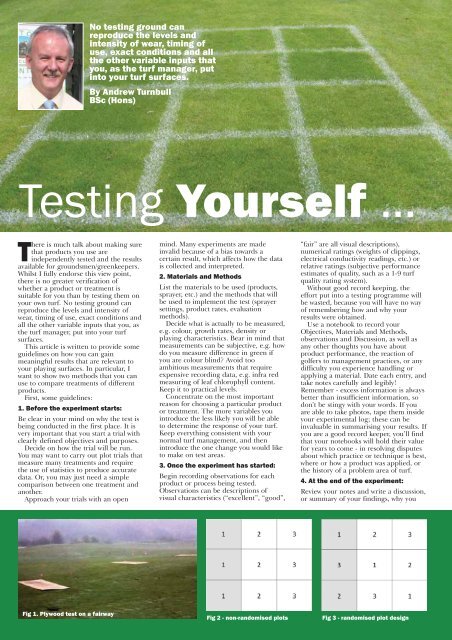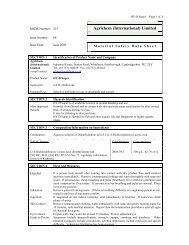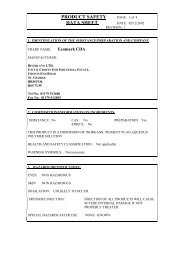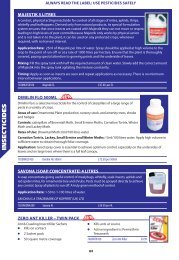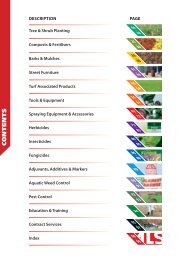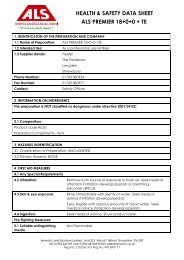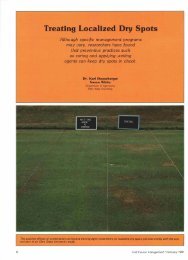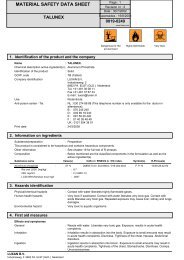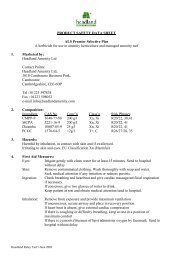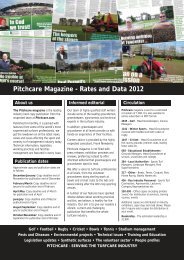Earning his Spurs - Pitchcare
Earning his Spurs - Pitchcare
Earning his Spurs - Pitchcare
Create successful ePaper yourself
Turn your PDF publications into a flip-book with our unique Google optimized e-Paper software.
No testing ground can<br />
reproduce the levels and<br />
intensity of wear, timing of<br />
use, exact conditions and all<br />
the other variable inputs that<br />
you, as the turf manager, put<br />
into your turf surfaces.<br />
By Andrew Turnbull<br />
BSc (Hons)<br />
Testing Yourself ...<br />
There is much talk about making sure<br />
that products you use are<br />
independently tested and the results<br />
available for groundsmen/greenkeepers.<br />
Whilst I fully endorse t<strong>his</strong> view point,<br />
there is no greater verification of<br />
whether a product or treatment is<br />
suitable for you than by testing them on<br />
your own turf. No testing ground can<br />
reproduce the levels and intensity of<br />
wear, timing of use, exact conditions and<br />
all the other variable inputs that you, as<br />
the turf manager, put into your turf<br />
surfaces.<br />
T<strong>his</strong> article is written to provide some<br />
guidelines on how you can gain<br />
meaningful results that are relevant to<br />
your playing surfaces. In particular, I<br />
want to show two methods that you can<br />
use to compare treatments of different<br />
products.<br />
First, some guidelines:<br />
1. Before the experiment starts:<br />
Be clear in your mind on why the test is<br />
being conducted in the first place. It is<br />
very important that you start a trial with<br />
clearly defined objectives and purposes.<br />
Decide on how the trial will be run.<br />
You may want to carry out plot trials that<br />
measure many treatments and require<br />
the use of statistics to produce accurate<br />
data. Or, you may just need a simple<br />
comparison between one treatment and<br />
another.<br />
Approach your trials with an open<br />
Fig 1. Plywood test on a fairway<br />
mind. Many experiments are made<br />
invalid because of a bias towards a<br />
certain result, which affects how the data<br />
is collected and interpreted.<br />
2. Materials and Methods<br />
List the materials to be used (products,<br />
sprayer, etc.) and the methods that will<br />
be used to implement the test (sprayer<br />
settings, product rates, evaluation<br />
methods).<br />
Decide what is actually to be measured,<br />
e.g. colour, growth rates, density or<br />
playing characteristics. Bear in mind that<br />
measurements can be subjective, e.g. how<br />
do you measure difference in green if<br />
you are colour blind? Avoid too<br />
ambitious measurements that require<br />
expensive recording data, e.g. infra red<br />
measuring of leaf chlorophyll content.<br />
Keep it to practical levels.<br />
Concentrate on the most important<br />
reason for choosing a particular product<br />
or treatment. The more variables you<br />
introduce the less likely you will be able<br />
to determine the response of your turf.<br />
Keep everything consistent with your<br />
normal turf management, and then<br />
introduce the one change you would like<br />
to make on test areas.<br />
3. Once the experiment has started:<br />
Begin recording observations for each<br />
product or process being tested.<br />
Observations can be descriptions of<br />
visual characteristics (“excellent”, “good”,<br />
“fair” are all visual descriptions),<br />
numerical ratings (weights of clippings,<br />
electrical conductivity readings, etc.) or<br />
relative ratings (subjective performance<br />
estimates of quality, such as a 1-9 turf<br />
quality rating system).<br />
Without good record keeping, the<br />
effort put into a testing programme will<br />
be wasted, because you will have no way<br />
of remembering how and why your<br />
results were obtained.<br />
Use a notebook to record your<br />
Objectives, Materials and Methods,<br />
observations and Discussion, as well as<br />
any other thoughts you have about<br />
product performance, the reaction of<br />
golfers to management practices, or any<br />
difficulty you experience handling or<br />
applying a material. Date each entry, and<br />
take notes carefully and legibly!<br />
Remember - excess information is always<br />
better than insufficient information, so<br />
don’t be stingy with your words. If you<br />
are able to take photos, tape them inside<br />
your experimental log; these can be<br />
invaluable in summarising your results. If<br />
you are a good record keeper, you’ll find<br />
that your notebooks will hold their value<br />
for years to come - in resolving disputes<br />
about which practice or technique is best,<br />
where or how a product was applied, or<br />
the <strong>his</strong>tory of a problem area of turf.<br />
4. At the end of the experiment:<br />
Review your notes and write a discussion,<br />
or summary of your findings, why you<br />
Fig 2 - non-randomised plots Fig 3 - randomised plot design


